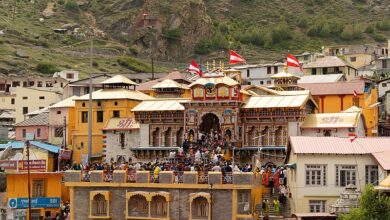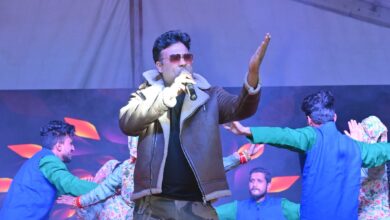Baikunth Dham and Baikunth Chaturdashi

Baikuntha Dham is the state of mind. This Baikuntha is not a place but a ground of spiritual realization. One who wants to go to Baikunth Dham, For him, knowledge is the only ray of hope. By this he becomes one with the nature of God. but within which is the supreme knowledge, unrelenting devotion to God, Only they can reach Baikunth. Where there is no frustration, it is called Baikunth.
7th November – Baikunth Chaturdashi
The mystery of birth and death, and the secrets of the movements of the deceased after death, often arouse curiosity in the mind. There is a mention of the movements after death in the Vedic texts, and detailed description of the conditions for attaining salvation after death is available, but nowhere in the Vedas there is talk of going to heaven or Baikunth after death. Nevertheless, according to mythological and cosmic beliefs, people have a belief that the heavenly world, Baikunth (Baikunth) Dham is located somewhere in this universe, where man can go only after death. Only virtuous human beings go to heaven or Baikunth after death. But the wish of every human being is to go to heaven after death. According to mythology, a person who does good deeds in life, performs highly virtuous deeds, helps others, gives food to the poor, does charity, worship, etc. and worships God with a pure heart and true heart. Heaven is attained, and only such a person goes to heaven after death and enjoys heavenly pleasures.
Similarly, in the whole life, never giving charity to anyone, not doing charity work, not helping others, worshiping the Lord, not doing the work of worshiping, harassing others, not helping anyone. On death, he gets hell and in hell he is punished according to his deeds. This is the reason why everyone wants to go to heaven after death. Majority of Hindus of India worship Lord Vishnu with devotion on Kartik Shukla Chaturdashi to attain Baikunth. That is why the day of Kartik Shukla Chaturdashi is famous as Baikuntha Chaturdashi.
In mythology, the position of Swarg Lok and Baikunth Dham in this universe has been mentioned in Krityug i.e. Satyug, Tretayug, Dwapar Yuga. In them, the details of sages-muni, sage-ascetic, mahatmas coming to heaven while alive are mentioned in Satyug, Tretayug, Dwapar Yuga. That is, at that time everyone knew that where is the swarga lok and the Baikunth dham? According to the legends, in the Treta Yuga, King Dasharatha used to go to heaven to fight on behalf of the gods. In Dwapar Yuga, Arjuna went to heaven in search of divine weapon. And to prepare for the war of Mahabharata, he went to heaven and got divine weapons. But it is a matter of surprise that in this Kali-yuga no one has seen Swarg Lok and Baikunth Dham. That is, no one knows where is the heavenly world and the Baikunth dham in this Kali-yuga? Western scientists have also made every effort to find out this thing, but today no one has been able to find the heaven or the Vaikunth Dham due to no divine power.
But in the mythological texts, the presence of heaven in this Kaliyuga has been told towards the pole star. Among all the stars in the sky, the pole star, which appears larger than other stars towards the north, can be easily recognized at night from any place on the earth. This Dhruv Tara i.e. Dhruv Lok was known as Bhuvar Lok in Satyug, Tretayug and Dwaparyuga. Situated about 14 lakh yojans away from the earth, in ancient times, Saptarishis and sages and sages used to reside in this Bhuvarlok. And after Bhuvarloka comes the heavenly world. Located at a distance of about one crore yojans from this Bhuvarlok is Meherlok, which is a part of the heavenly world itself. The great ascetic sages who are engrossed in the devotion of God reside in this Meherlok, which looks like heaven. Swarg Lok, popularly known as Jan Lok, is at a distance of about two crore yojans from Maihar Lok. The gods and goddesses reside in this heaven. In this, the virtuous soul goes after the death of man. After going here, there is a vision of the gods and goddesses of heaven. And here it can be reached only after death. To attain this heaven, sages do penance for years. To go to heaven, you should do good deeds in your life. Heaven is attained by doing good deeds.
According to mythological belief, the abode of Lord Vishnu i.e. Lok is called Baikunth. Baikunth Dham is the world of Jagatpalak Lord Vishnu. Like Mahadev resides on Kailash Lok, Brahma resides in Brahmaloka, Vishnu resides in Vishnuloka. It has also been designated by the names of Saket, Goloka, Vishnuloka, Vaikunth Dham, Vaikuntha Sagar, Paramdham, Paramsthan, Parampad, Paramvyom, Sanatan Akash, Shashwat-pad, Brahmapur etc. Man gets a place in this world only by the majesty of very virtuous deeds, and the one who reaches here, because of the attainment of salvation, he does not get pregnant again. some
Six people say that Baikunth Dham is a state of mind. This Baikuntha is not a place but a ground of spiritual realization. For one who wants to go to Baikunth Dham, knowledge is the only ray of hope. By this he becomes one with the nature of God. But only those who have supreme knowledge, have exclusive devotion to God, can reach Baikuntha. Where there is no frustration, it is called Baikunth. Frustration means inaction, indolence, despair, frustration, laziness and poverty where there is no. That is, a place where there is no worklessness, no inaction, no despair, despondency, laziness and poverty, is Baikunthalok. There can be, and are, many such places in this worldly world too, where there is no inactivity and there is always a glow.
In the mythological texts, the position of Vaikuntha Lok, the abode of Vishnu, has been considered at three places – on earth, in the sea and above heaven. Vaikuntha is also called Vishnuloka and Vaikuntha Sagar. Shri Krishna is considered to be an incarnation of Vishnu, that is why the abode of Shri Krishna is also called Goloka i.e. Vaikuntha. Badrinath, Jagannath and Dwarkapuri are also called Vaikunth Dham on earth. The most sacred of the Char Dhams in Indian tradition, Badrinath is situated on the left bank of the Alaknanda River, surrounded by the Nar and Narayan mountain ranges, against the backdrop of the Neelkanth mountain range. Located in the north of India, this temple of Badrinath is considered to be the court of Lord Vishnu. In Badrinath Dham, the five forms of the adorable god Badrinarayan are worshipped. These five forms of Vishnu are known as Panch Badri – Shri Vishal Badri, Shri Yogadhyana Badri, Shri Bhavishya Badri, Shri Vriddha Badri and Shri Adi Badri.
According to the belief, Badrinath Dham was established by Narayan in Satyug. In Tretayuga, Rameshwaram was established by Maryada Purushottam Shri Ram himself. In Dwapar Yuga, Dwarkadham was established by Yogishwar Shri Krishna and in Kali Yuga Jagannath Dham is called Vaikuntha. In the Puranas, the temple of Jagannath Puri inscribed in the name of Baikunth of the earth is famous all over the world. According to Brahma and Skanda Purana, Lord Vishnu incarnated as Purushottam Nilamadhava in Puri. The position of the second Baikuntha is described above this earth i.e. outside the universe and above the three worlds. It is three times larger than this visible nature. Ninety-six crore councilors of Lord Vishnu are appointed to take care of it. All the souls that are liberated from this world enter this supreme abode with conch shell, chakra, mace and padma. And then from there that soul will never return again. Here Shri Vishnu resides with his four wives Sridevi, Bhudevi, Neela and Mahalakshmi. It is believed that after death the virtuous souls of Vishnu devotees reach this world.
According to the Puranas, the position of this Vaikuntha is beyond our universe. The Gods of Time, Gods of Prahar, Gods of Day, Gods of Night, Gods of Days, Gods of Planets, Gods of Nakshatras, Gods of Months, Gods of Seasons, on the way to send off the souls who travel this Vaikuntha The deities of Paksha, the deities of Uttarayan, the deities of Dakshinayana, the deities of all the tala-atalas, sutras, underworlds, etc., all the thirty-three categories of deities first try to push him again into a vagina, or prevent him from letting go of Vaikuntha, but All these souls who take refuge in Lord Vishnu take them to the end of the Ekapad Vibhuti and drop them on the banks of the river Viraja which flows out of the Tripad Vibhuti. In this Ekapad Vibhuti our entire universe and all the worlds are situated. After the limit of this Ekapad Vibhuti, the Baikunth Dham begins.
A river called Viraja flows between this Vaikunth Dham and Ekapad Vibhuti. Tripad Vibhuti starts from this river, which is known as Vaikunthalok. When all the gods leave the liberated soul up to the river Virja, then that liberated soul takes a dip in the river and goes across it. From that side the councilors take him directly to Shri Hari Vishnu. There he attains supreme bliss by seeing them. In this way, in the Tripad Vibhuti itself, that soul is established forever. A detailed description of this Vaikunth Dham is mentioned in the Puranas. According to the Puranas, Lord Krishna had established another city in addition to Dwarka, which was called Baikunth.
According to some archaeologists and historians, Vaikunth Dham was established somewhere on the hill range of Aravalli, where not humans, but only seekers lived. The Aravalli or Arvali is a north Indian mountain range. Aravalli is the oldest mountain in India in the geographical structure of India. It is here that Shri Krishna had established the city of Vaikunth. In Rajasthan, this mountain running from the south-east direction has reached almost to Delhi in the north-east. Some rocky hills of this 560 km long range passing through the northeastern region of the state of Rajasthan have gone up to the south part of Delhi. The mountain of Arbud or Mount Abu on the edge of Gujarat is one end and the small hills near Delhi are Dheeraj the other end.





